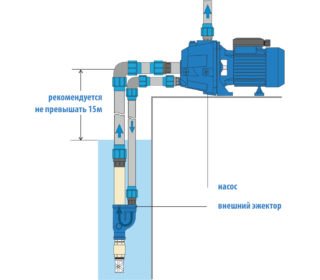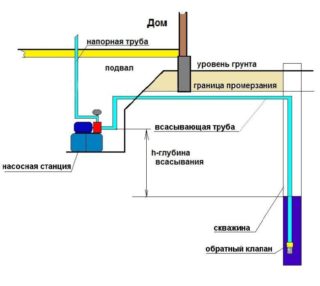Pumping stations are increasingly used for autonomous water supply systems, in which water intake is organized from wells, wells or open reservoirs. Pumping units are selected according to three parameters: suction depth, productivity, head. The maximum suction depth of the pumping station is the limit value with which the settings are selected.
Suction depth

There are two types of NS, which differ in the presence or absence of an ejector. The latter is a kind of additional pump (without an electric motor), with the help of which the possible water intake depth is increased.
The rated suction depth, as a rule, is - 8 m. This is provided that there is no ejector in the station configuration. If this device is present in the water intake system, the indicator may increase. Manufacturers offer pumping stations with a built-in ejector. Practice has shown that such attitudes are quite capricious. It is not always possible with their help to raise water from wells of the declared depth.
A more convenient location is a remote ejector. It is installed at the end of the water intake hose (plastic pipe or rubberized hose), where it is fixed with a plastic clamp. But such a design reduces the efficiency, because a certain water speed is required for the ejector to work. The pump lifts the liquid to the surface, part of it drives it back to the ejector through a parallel pipeline. The movement of water, first up and then down, reduces the efficiency of the pumping unit.
The suction depth of a station with a built-in ejector is no more than 9 m. With a remote one - no more than 10.5 m. On many sites there is an indicator of 45 m. This is misinformation. The NS has several technical characteristics, where 45 meters is the maximum distance from the water mirror inside the well to the last consumer in the autonomous water supply network. The indicator often appears in passport data, but it is not the only one. On the market, you can find stations for which this distance exceeds the indicated value.
Water rise indicators
In the NS passport, the manufacturer always indicates the maximum values of the technical characteristics. When buying equipment, it is imperative to take into account the ratio of these characteristics with the technical indicators of the water supply system at home. If you choose the wrong station for the water supply, there is a high probability that the latter will not work correctly. For example, there will be insufficient water or the pressure will be weak.
In the product passport, the manufacturer must indicate the graphical dependence of all characteristics among themselves. With its help, you can see the dependence of the pressure, the flow rate of the installation to the characteristics of the water supply system. On its basis, the buyer can independently select the model of the pumping station, taking into account the indicated characteristics and the suction depth.
How to calculate the required suction depth of a pumping station
- The distance from the water mirror in the well to the consumer, which is located at the farthest point in the water supply network. In this case, the distance is added up from all sections, because the network is usually not straight. The more branches, the greater the head and flow losses.
- Distance from the pumping station to the place of water intake. The equipment can be installed near a well, in the basement of a house or in a specially constructed room.The farther the station is located, the greater the loss, the shallower the suction depth.
- Number of fittings and valves. Here you can take a 10% stock of all characteristics - the head and productivity of the pumping station.
- Dynamic water level in the well. This value changes depending on the season and the intensity of water withdrawal. It must be taken into account when calculating the suction depth. In this case, it is necessary to know that the end of the suction pipe must be at least 1 m below the water surface. If the dynamic level is high, it is highly likely that in the summer season the water in the well will fall below the installation level of the end of the suction pipe.
- The diameter of the pipes used in the plumbing system.
- The number of consumers.
The dynamic water level in an autonomous water supply system plays one of the most important roles. If you neglect its value, you can forget about the characteristics of the water supply network.
The largest loss of water pressure inside the water supply system is vertical. The suction depth affects the characteristics of the water supply system. The larger it is, the more proportionally the indicators decrease. For example, if the reading is 8 m, the pressure loss is reduced by 0.8 bar.
To combat the decrease in the depth of the water intake, a caisson is installed above the well. This is a special cylindrical or cubic container that is buried at a certain depth. NS is mounted in it. The higher the caisson height, the lower the pump will be located. Thus, it is possible to reduce the installation site of the alluvial station and reduce the distance from it to the water surface.
There is another option. A metal structure assembled from a metal profile (usually a corner or channel) is installed inside the well. It is attached to the walls of the hydraulic structure. A pumping station is mounted on this support. To ensure higher characteristics of the water supply network, the support structure is lowered to the level of the water surface in the well. The disadvantage of such an installation is that the station is located at a great depth, which means that it will not be easy to monitor and maintain it.










At a water suction height of more than 8 meters, cavitation (vacuum boiling of water) occurs in the suction pipe, which tears off the water column with air bubbles and the pump runs dry, and the water does not rise. An ejector can raise water up to 20 meters, but with a large energy consumption, the water flow is scanty, a little more with a hydraulic elevator, but the game is not worth the trouble.
Well 29 meters, statics 18, dynamics when withdrawing 2.5 cubic meters per hour 23 meters. The ejector hangs at a depth of 26.5 meters, the site is on an elephant and the house is almost 4 meters higher than the well. The station is in the house, in the basement at the ground level. In total, from the station to the water surface 4 + 18 = 22 meters when the station is turned on and 4 + 23 = 27 meters, the water can go down to this level if we allow the pool to be filled in the summer. The station has been regularly pumping water for the eighth year. And you write that 10.5 meters is the limit. Leave people astray!
I generally have a pumping station without an ejector, it is at home, a well of 25 meters, two floors, it lifts to the second floor without problems, it has been working for 3 years.
Can lift at least 100 meters! The question is from how many meters to take water! Pay attention